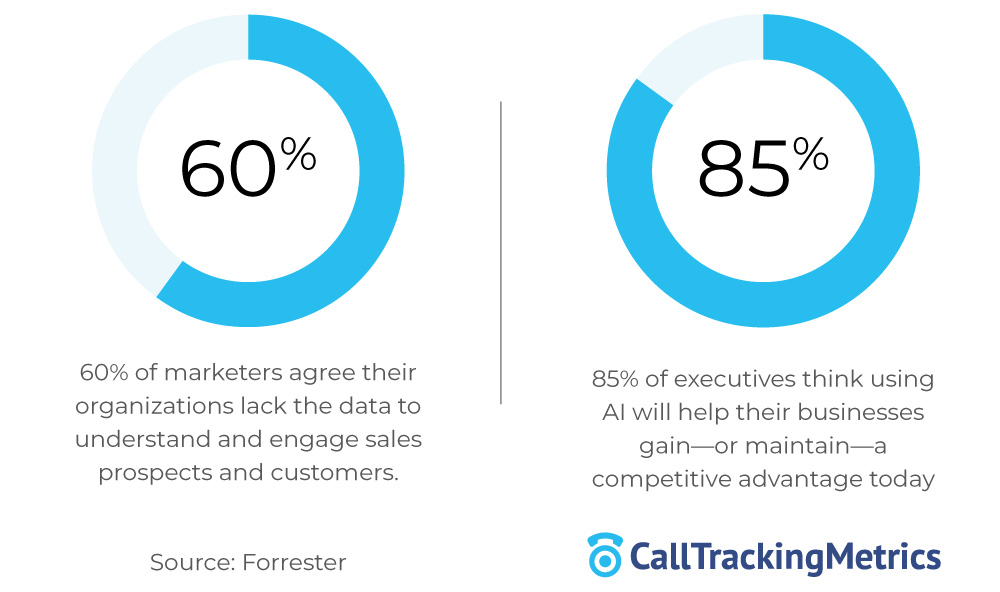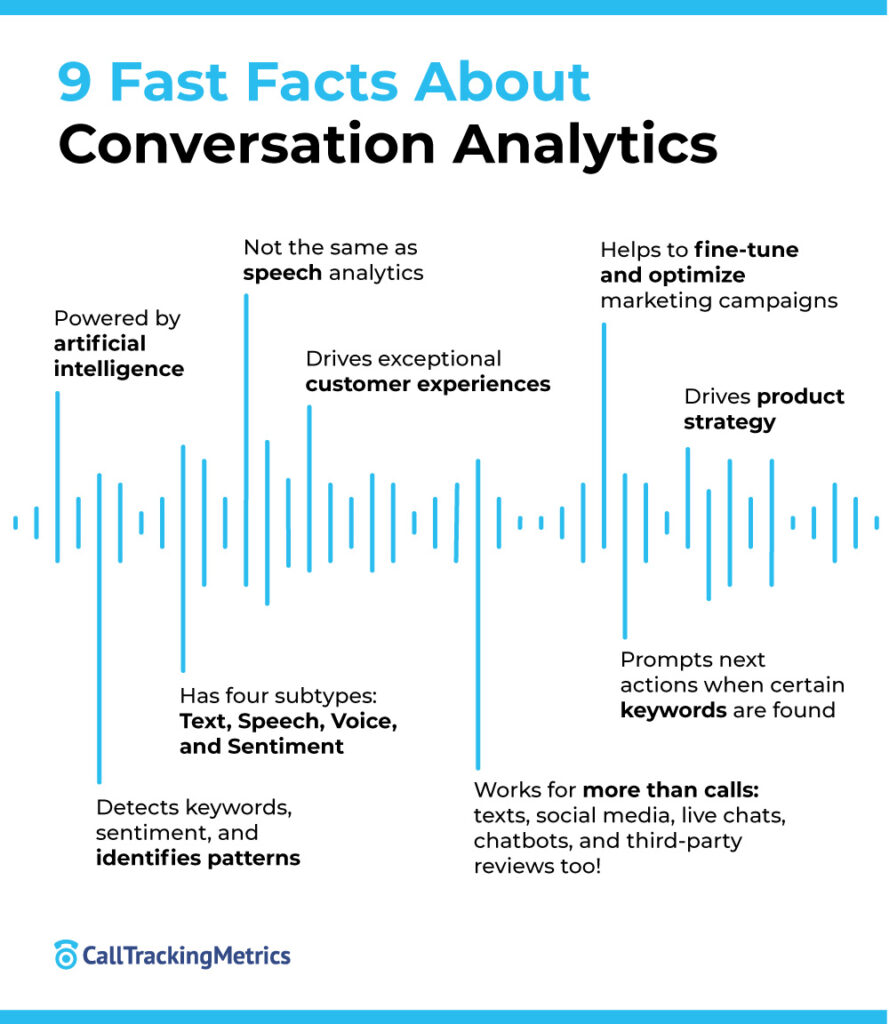9 Conversation Analytics Fast Facts
Read Time Five Minutes
Conversation analytics is the process of using advanced technology to analyze data from both phone calls and text conversations. This analyzed data is then used for insights that guide marketing and sales teams as well as other organizational initiatives.
If you aren’t using it, your competition may be leaving you in the dust. In fact, a Forrester report found that 85% of executives think using tools backed by technology, like conversation analytics, will help their businesses gain–or maintain–a competitive advantage today.
Conversation analytics helps marketers and sales teams gain firsthand insight into their customers. For these teams, knowing who your customer is, what problems they have, and how your product or service can solve the problem is worth its weight in gold. And conversation analytics delivers just that.
Why is Conversation Analytics Important?
With the demise of third-party data and the continual changes in privacy rules and regulations, first-party data is more important today than ever before. It’s critical to know what your prospects and customers are saying, how they’re interacting with your product or service, and how they respond to your marketing campaigns. Armed with this actionable data and customer information teams can optimize strategies for optimal success. Conversation analytics helps you understand how your customers think, feel, and behave. Teams who aren’t using conversation analytics are missing out on key data and insights.

While many marketers know the importance of this data, far too many aren’t getting it. In fact, according to Forrester, 60% of marketers agree their organizations lack the data to understand and engage sales prospects and customers. If you aren’t engaging prospects and customers–your competition will. Employing conversation analytics, also referred to as conversational analytics, can make the difference between a so-so year and a record-breaking one.
If you don’t know much about conversation analytics here are some fast facts to get you started.
Conversation analytics is:

1. Powered by Artificial Intelligence
Artificial intelligence or AI has taken the world by storm–and continues to do so. According to Bloomberg, the AI market size is expected to grow at 39.4% CAGR between 2022 and 2028. Advanced technology, like AI, is often part of conversation analytics and can be used to convert conversations into a format readable by machines. Once in machine-readable form, it then uses sophisticated statistical algorithms and applies them across conversations to detect patterns and trends, find anomalies, and pinpoint causes for these trends.
2. Detects keywords, sentiment, and identifies patt
Conversation analytics can detect keywords used, extract sentiment, find patterns, and prompt responses. Each of these can be used to automate next steps, improve the customer experience, and fine-tune strategies.
3. Works for calls, texts, social media, live chats, chatbots, and third-party reviews
Modern conversation analytics doesn’t just transcribe and analyze phone calls and texts. Today, conversation analytics can detect keywords, sentiment, and patterns in chats-both live and chatbots, in social media comments and mentions, and in third-party reviews. This type of analysis gives you comprehensive data on what your customers are saying–and what they need.
4. Isn’t the same as speech analytics
Speech analytics is a type of conversation analytics that uses transcriptions to convert voice conversations into text which is then converted into machine-readable text for analysis of keywords, patterns, etc.
5. Has four subtypes
Conversation analytics can be grouped into four different categories or types. While many types of software use all of these subtypes together, it’s important to recognize the differences. Organizations using the term conversation analytics may use different subtypes or all of them. These types are:
- Text analytics
Text from emails, chats, social posts, and texts are converted to machine-readable format through natural language processing (NLP.) It then detects patterns and insights and reports on them.
- Speech analytics
As mentioned above, speech analytics employs parts of text analytics once the voice conversations are transcribed.
- Voice analytics
This type of conversation analytics takes a look at how something was said instead of what was said. Using AI, this type of analysis is able to identify pauses, changes in voice pace, etc. to detect frustration, satisfaction, etc.
- Sentiment analysis
Demand for sentiment analysis continues to grow and with good reason. This type of conversation analytics is similar to voice analytics and helps teams to understand through the use of various tools whether a conversation is positive, negative, or neutral. Sentiment analysis is often used to monitor social media channels and other channels for customer feedback.
6. Drives exceptional customer experiences
When you know your customer better, understand their problems and challenges, and get what makes them happy, you’ll be better able to provide great customer experiences. An Opus report found that 49% of organizations say using speech analytics has helped them support customer satisfaction. Listening to customers matters.
Getting the firsthand data available through conversation analytics gives your teams the information they need to provide customers with these experiences time and time again. This drives loyalty and creates brand advocates.
7. Helps to fine-tune and optimize marketing campaigns
Understanding your prospects and customers is key to any successful marketing campaign. When you get direct insight into which campaigns are performing well and driving the highest-value leads and conversions, you can optimize campaigns and budgets because you’ll know precisely where to focus your efforts and where to pull back.
8. Focuses product strategy (bug fixes, product likes, etc.)
Receiving consistent insight from conversations your team is having with customers helps with proactively identifying and responding to product or service issues. In addition, when teams are sent information about patterns being detected, they can tailor their product and services to better meet the needs of their customers.
9. Prompts next actions when certain keywords are found
Today’s world demands fast action. When a customer is ready to take action it’s essential that organizations promptly respond. A report from Vonage, a cloud communications provider, found that 46% of customers reported they were highly likely to stop engaging with a business if their calls go unanswered and there are no other options available for support.
Conversation analytics not only detects certain keywords and patterns but can also automate responses and next actions. These actions can vary from alerting a sales manager when negative words are detected to sending an automated text follow-up to thank a customer for their business or ask for a review. Not only does it help you be certain you never miss a hot lead, but it also saves time by automating tedious tasks.
Summary of Conversation Analytics Fast Facts
The possibilities with conversation analytics are unlimited. From optimizing strategies and initiatives across entire organizations to providing marketing teams with first-hand insight, conversation analytics offers the insight organizations need to thrive in today’s competitive landscape. And insight today is vital. According to Forrester, insights-driven businesses are 8.5 times more likely to report at least 20% revenue growth in 2021.
Find out exactly what CallTrackingMetrics and conversation analytics can do for your team. Book a Demo and see CTM in action!